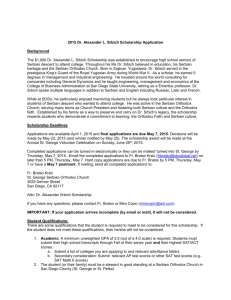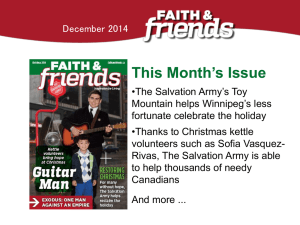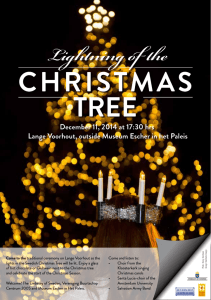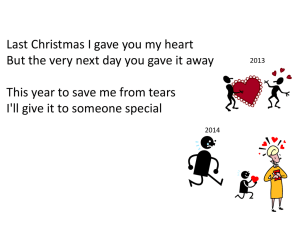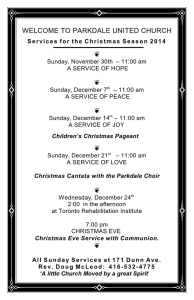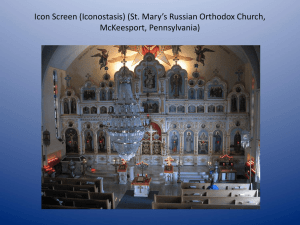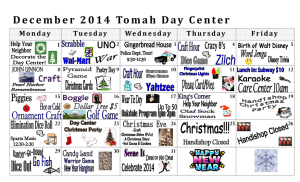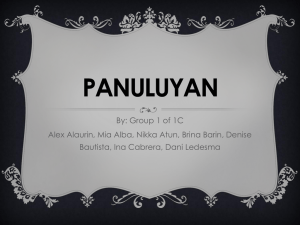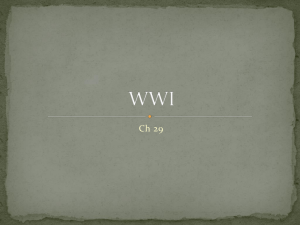Religion in Serbia
advertisement
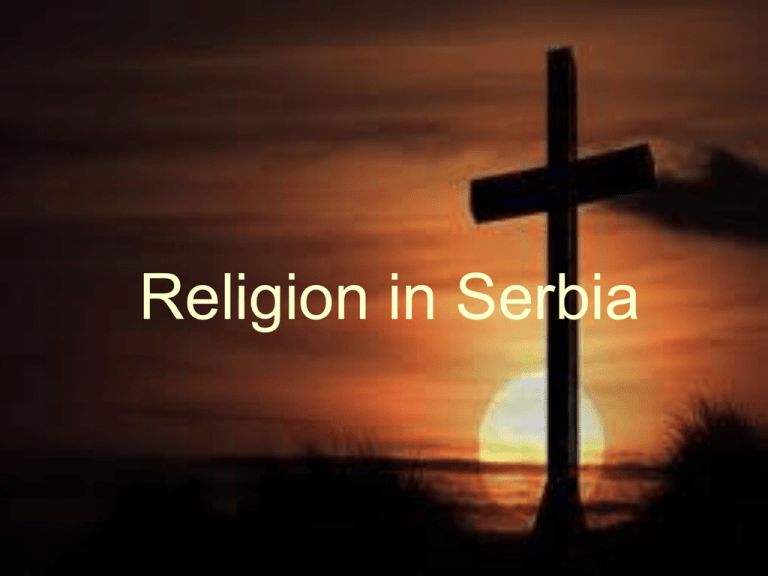
Religion in Serbia • Serbia is a multi-religious country. The dominant religion is Orthodox Christianity (notably the Serbian Orthodox Church), but there are also some adherents of Islam (living mostly in the southwestern part of Serbia in the region of Sandžak or Raška, in the municipalities of Preševo and Bujanovac in southern Serbia, as well as in the disputed territory of Kosovo), and Catholic Christianity (living mostly in northern part of Vojvodina province), as well as adherents of other religious groups such are Protestant Christians, Jews, and others. • • • • • Yellow-Catholic Green- Islam Blue-Ortodox Brown-Protestants Gray-No data Census 1921 Census 1991 3 321 090 6 347 026 Census 2002 6 371 584 751 429 496 226 410 976 97 672 224 120 239 658 Protestants No data 88 275 80 837 Jews 26 464 740 785 Greek Catholics Total 16 859 No data No data 4 378 595 7 759 571 Orthodox Cristians Roman Christians Muslims 7 498 001 • The head of the Serbian Orthodox Church is the patriarch. He is also the head (metropolitan) of the Metropolitanate of Belgrade and Karlovci. The current patriarch is Irinej since 22 January 2010. The Serbian Orthodox patriarchs are styled His Holiness the Archbishop of Peć, Metropolitan of Belgrade and Karlovci, Serbian Patriarch. The highest body of the Church is the Holy assembly of Bishops (Serbian: Sveti arhijerejski sabor, Свети архијерејски сабор). It consists of the Patriarch, the Metropolitans, Bishops, Archbishop of Ohrid and Vicar Bishops. It meets twice a year in spring and in autumn. Holy assembly of Bishops makes important decisions for the church's life and elects the patriarch. The executive body of the Serbian Orthodox Church is the Holy Synod. It has five members: four bishops and the patriarch. Holy Synod takes care of everyday life of the Church. It meets on regular basis. • Icons are replete with symbolism meant to convey far more meaning than simply the identity of the person depicted, and it is for this reason that Orthodox iconography has become an exacting science of copying older icons rather than an opportunity for artistic expression. The Orthodox believe that the first icons of Christ and the Virgin Mary were painted by Luke the Evangelist. Orthodox regard their depiction of Christ as accurate, with Christ having brown semi-curly hair, brown eyes, and Semitic features (the Virgin Mary being similar). • Trojeručica (three-handed) icon of Virgin Mary in Hilandar, the most important icon of the Serbian Church • Fresco of the White Angel in Mileševa, the most famous Serbian fresco • Miroslav Gospels, one of the oldest surviving documents written in Old Church Slavonic from 12th century (World Documentary Heritage) Serbian Christmas traditions • Serbian Christmas traditions are customs and practices of the Serbs associated with Christmas and a period encompassing it, between the third Sunday before Christmas Day and Epiphany. There are many, complex traditions connected with this period. They vary from place to place, and in many areas have been updated or watered down to suit modern living. The Serbian name for Christmas is Božić (Cyrillic: Божић, pronounced [bɔ̌ʒitɕ]), which is the diminutive form of the word bog "god", and can be translated as "young god". Christmas is celebrated for three consecutive days, starting with Christmas Day, which the Serbs call the first day of Christmas. On these days, one is to greet another person with "Christ is Born," which should be responded to with "Truly He is Born," or in Serbian: „Христос се роди“ [xristɔs sɛ rɔdi] – „Ваистину се роди“ [ʋaistinu sɛ rɔdi]. • The Serbian name for Christmas Eve during the day is Badnji dan. After sunset it becomes Badnje veče. On this day the family makes preparations for the oncoming celebration. The dinner on this day is festive, copious and diverse in foods, although it is prepared in accordance with the rules of fasting. • Early in the morning the head of each family, usually accompanied by several male relatives, selects and fells the tree from which the log will be cut for their household. The group announces its departure by firing guns or small celebratory mortars called prangija. The Turkey oak is the most popular species of tree selected in most regions, but other oaks, or less frequently other kinds of tree, are also chosen.Generally, each household prepares one badnjak, although more are cut in some regions. • When the head of household finds a suitable tree, he stands in front of it facing east. After throwing grain at the tree, he greets it with the words "Good morning and happy Christmas Eve to you", makes the Sign of the Cross, says a prayer, and kisses the tree. • Upon entering the house the man approaches the fireplace, called ognjište ([ˈɔɡɲiːʃtɛ])—the hearth of an ognjište is similar to a campfire, in that it has no vertical surround. He lays the badnjak down on the fire and moves it a little forward, to summon prosperity for the household. Any other logs are brought in by other males and laid on the fire parallel or perpendicular to the first. The head of the household takes a jug of wine and pours some on the badnjak; in some regions, he may strew wheat grains over the logs. He then proposes a toast: "Grant, O God, that there be health and joy in this home, that our grain and grapevines yield well, that children be born healthy to us, that our property increase in the field, pen, and barn!" or similar. The head drinks a draught of wine from the jug, after which it is passed to other members of household. When the log has burnt through, some families let the fire go out, while in others the men keep watch in shifts during the night to keep the badnjak burning. • On Christmas Day, the celebration is announced at dawn by church bells, and by shooting from guns and prangijas. The head of household and some of the family go to church to attend the Morning Liturgy. No one is to eat anything before tasting the prosphora, which the head of household brings from church for those who stay at home to do domestic tasks for this morning. • Christmas dinner is the most celebratory meal a family has during a year. Аbout noon, or even earlier, the family members sit down at the table. When the head of household gives a sign, all rise. He lights a candle, censes his family and house, and prays the Lord's Prayer. After that, the family members kiss each other on the cheek saying, "The peace of God among us, Christ is Born." The head and another man of the family hold the česnica between themselves, rotating it three times counterclockwise. The česnica is then carefully broken among the relatives, so that each of them gets his or her own share of the loaf. The family member whose share contains the coin hidden in the česnica, will supposedly be exceptionally lucky in the coming year. The main course of Christmas dinner is roast pork or pečenica. During the dinner, the head of the household proposes a toast to his family with a glass of wine, several times. Serbian Patron Saint Day • Of all Orthodox Christians, only Serbians have a slava -the custom of celebrating a family's patron saint's feast day. • The tradition dates back to the ninth century when Serbs gave up their pagan beliefs and accepted Christianity. • One theory is that each village or tribe adopted a collective saint as its protector; another is that the saint on whose day a man was baptized became his family's patron. • In commemoration of their conversion or spiritual birthday, each family began a yearly celebration to honor their saint, passing the tradition down from generation to generation. • The most common Slavas are St. John the Baptist on Jan. 20, St. George on May 6, St. Michael the Archangel on Nov. 21 and St. Nicholas on Dec. 19, but there are many others. • Serbian priests visit homes in their parish to bless slavski kolac (a special slava bread), zito, also known as koljivo (boiled wheat with honey and walnuts) and red wine, and light a special beeswax candle before any feasting can begin. • Kolac represents Christ as the bread of life. Zito is symbolic of Christ's resurrection and commemorates departed family members. Red wine is symbolic of Christ's blood, and the candle proclaims Christ as the light of the world. • Kolac is a round 6-inch-high yeast bread with braided dough around its perimeter, a cross on the top and a pecat or seal with the letters IC, XC, NI and KA, which stand for "Jesus Christ the conqueror." A Cyrillic "C" in each quadrant of the cross stands for samo, sloga, Srbina, spasava, which mean "Only unity will save Serbs." The most famous Serbian monasteries • Visoki Dečani monastery, major Christian monastery located in disputed Kosovo, 12 km (7 mi) south of the town of Peć. The monastic katholikon is the largest medieval church in the Balkans containing the most extensive preserved fresco decoration • Hilandar (Serbian Cyrillic Хиландар, Greek Chilandar) is a Serbian Orthodox monastery on Mount Athos in Greece • Church of the Žiča monastery in Kraljevo, the royal church of the medieval Serbian kings • Church of the Mileševa monastery near Prijepolje is known for its remarkable frescoes • The Virgin's Church of the Studenica monastery near Kraljevo, World Heritage site • The (Orthodox) Temple of Saint Sava (Serbian: Храм Светог Саве) in Belgrade, Serbia is the largest Orthodox Church currently in use Thank you for your time!
